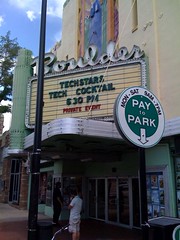Getting Out From Behind Your Desk
It's accepted wisdom that managers need to get out from behind their desks and walk around the office checking in with the team, talking to people, answering questions, and firing people up. I encourage every entrepreneur and manager we work with to do that regularly.
But how does a VC "get out from behind your desk"? We work in small offices surrounded by our colleagues and usually are connected to our portfolio companies by email and the phone (and twitter).
Yesterday was a great day for me. I got to get out behind my desk not once but twice.
In the morning, I hopped on the subway and headed up to visit one of our portfolio companies. They showed me some new stuff they are working on and we talked over a few features, how they should implement them, and some interesting design choices they are making. It was an hour and a half of deep dive on product and I loved it. I hope they get as much out of the meeting as I did.
Then in the late afternoon, I hopped on the same subway, headed up to the same part of town (the garment district which is quickly becoming the web district) and talked to the entire team of another company I am involved with. They asked me to talk to the team about the venture business, what we invest in, why I wanted to get involved with that specific company, and what I am excited about in their business. Then I took questions for about 25 minutes. The Q&A was fast and furious and very stimulating. Again, I hope they got as much out of that talk as I did.
I was supposed to do something similar with another one of our companies this week, but it was postponed for a couple weeks. I am looking forward to that talk too.
These kinds of sessions, where I get to engage deeply with one of our investments, are the best part of the work I do. I love meeting new people, hearing new ideas, getting excited about new investments. And of course I love watching our companies launch new things and drive their business forward. I particularly love that magic moment when they become profitable and are no longer dependent on the mercy of VCs and the capital markets. But the very best part of the venture capital business is when we get out from behind our desks and get into the portfolio companies. I want to do it more and I suspect every VC does.
![Reblog this post [with Zemanta]](http://img.zemanta.com/reblog_b.png?x-id=68b411e4-0482-4429-8400-a799400d22c8)
![Reblog this post [with Zemanta]](http://img.zemanta.com/reblog_b.png?x-id=d1bc87ea-af55-4145-81f7-685ab32cb069)
![Reblog this post [with Zemanta]](http://img.zemanta.com/reblog_b.png?x-id=1ffedbac-9bfe-419a-baa1-9a66ce0848fe)
![Reblog this post [with Zemanta]](http://img.zemanta.com/reblog_b.png?x-id=97853a47-1631-4790-b05e-f329ca714bb8)


![Reblog this post [with Zemanta]](http://img.zemanta.com/reblog_b.png?x-id=b276c543-54af-4823-b183-48dd048de8b8)

![Reblog this post [with Zemanta]](http://img.zemanta.com/reblog_b.png?x-id=6f994a51-f913-4937-b9af-721329c9d0ec)
![Reblog this post [with Zemanta]](http://img.zemanta.com/reblog_b.png?x-id=590376b7-ea83-454b-8f8e-c6844f5c3a42)
![Reblog this post [with Zemanta]](http://img.zemanta.com/reblog_b.png?x-id=a1aea2f3-b7e7-4ca7-9029-c4d086e88ce1)